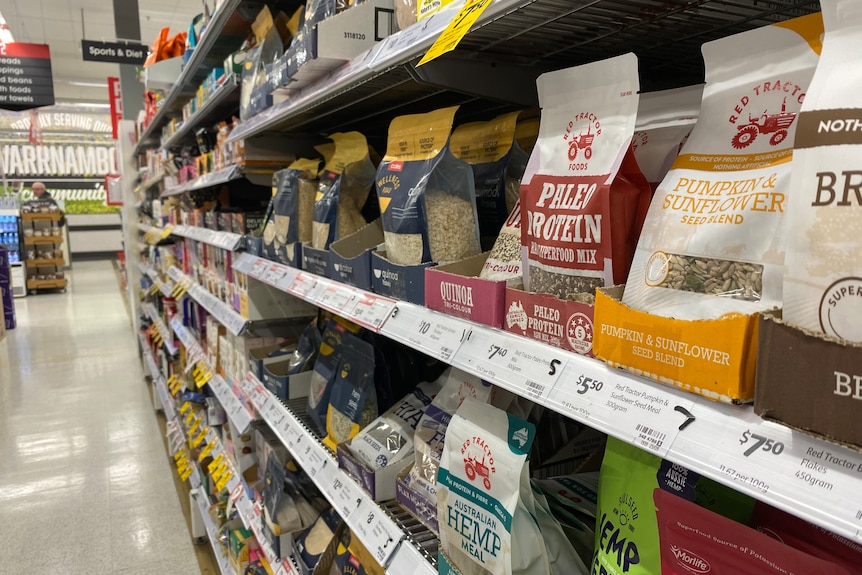Eating healthily can be less expensive than the unhealthy diet many Australians currently live on, a new study has found.
Key points:
- There’s a perception that healthy food costs more, but it can save you money, research finds
- A trolley of healthy food costs $150 less a fortnight than what the average Australian family buys
- The takeaway message? Try to eat five serves of vegetables a day and replace processed food with fresh food
A regional Victorian hospital’s health promotion unit has shown that by following the recommended Australian Dietary Guidelines, families can save $150 at the checkout a fortnight.
And that’s without needing to buy expensive items from the heath food aisle.
But it does involve wheeling the trolley past national favourites like sausages and beer, wine and preserved meats, fruit juice, sweet snacks and muesli bars.
The study took a trolley to the supermarket aisles to test the affordability of the Australian Dietary Guidelines, comparing the cost of the recommended diet to what an average Australian family buys and eats a fortnight.
‘Back to basics’
The study is part of a food affordability project at Warrnambool Base Hospital’s South West Healthcare: Healthy Communities.
Project coordinator Caitlyn Hoggan says the cost of living is overwhelmingly the perceived barrier to a healthy diet for the average Australian family.
“We did a study earlier this year looking at people’s dietary habits and what people are purchasing and consuming in Warrnambool,” she says.
“We found that price was the biggest concern when it comes to people choosing what to eat.”
“There is a perception that healthy food costs more, but our research shows that eating [according to] the Australian Dietary Guidelines saves money.”
ABC News: Emily Bissland
)
Ms Hoggan says the guidelines are “nothing groundbreaking” but are just “back to the basics” when it comes to healthy eating.
“It’s the good old fruit and vegetables; five serves of vegetables, two serves of fruit a day,” she says.
“Those healthy wholegrains and dairy as well, we recommend eating those five food groups.”
What Aussies eat
According to the CSIRO, Australians can no longer claim to be the bronzed, muscle-bound nation we once were and are in fact “failing when it comes to embracing a balanced diet”.
The CSIRO’s 2023 report, released in September, compared what we eat to the national recommendations.
Co-author Gilly Hendrie, a CSIRO research scientist, found only 35 per cent of the population is eating the recommended amount of vegetables.
And when it comes to our diet score, with an average score of 55 out of 100, we barely pass.
“The score is a stark reminder of the work that needs to be done to improve our eating habits and reduce the national waistline,” Dr Hendrie said.
Trolley test
In the Warrnambool study, one supermarket trolley was healthy and filled with enough food to feed a family of four for a fortnight, but limited to products recommended in the Australian Dietary Guidelines.
Thirty-one per cent of this trolley was fruit and vegetables. It also had grains and cereals like bread and rice, lean meats such as mince and chicken, dairy products like cheese and milk, and olive oil.
The second trolley was less healthy and filled with what the average Australian family buys and eats each fortnight.
Only 13 per cent of this trolley was made up of fruit and vegetables.
It also contained all of the staples in the first trolley, but with the addition of butter, sweetened drinks, desserts, processed meats like sausage and ham, convenience meals and fast food such as pizza, meat pies and hamburgers.
Add a few bottles of wine and a case of beer to the second trolley, and the scales are tipped.
The proof is on the docket: the healthy trolley comes in about $150 cheaper a fortnight. That’s equal to $3,900 a year.
Ms Hoggan says the takeaway message is to try to eat five serves of vegetables a day and swapping out processed food for fresh food as much as possible.
“Every serve of vegetables counts, whether it’s a salad roll, swapping meat for beans, or some vegetable sticks and dip as a snack,” she says.
“We know that vegetable intake is foundational to good health. Diets rich in fruit and vegetables have been shown to protect against high blood pressure, heart disease, stroke, Type 2 diabetes and some cancers.”
On top of this, research also shows that having the willpower to wheel past the snack aisle can lead to a happier, healthier state of mind.
“A well-balanced diet can boost your mood and improve mental wellbeing,” Ms Hoggan says.
Small changes
Ms Hoggan concedes that, in real life, following the recommended diet can be hard.
The diet recommends avoiding many foods of convenience, from ham for sandwiches and muesli bars for school lunches to ready-made meals.
That could make the diet impractical for a families with working parents.
“It is really challenging,” Ms Hoggan said.
“We’re absolutely not saying that to be able to eat this way all the time is easy, but we do know that any small change that we make, any increase in fruit and vegetables, is a positive step in our health.”
For families keen to make a healthy, affordable change, Ms Hoggan suggests starting small, planning meals with your kids, and trying to make healthy versions of takeaway meals at home.
